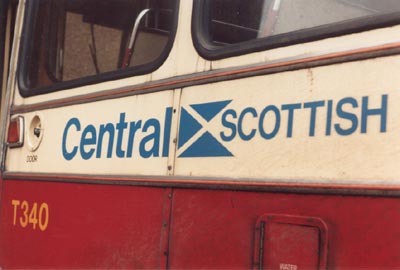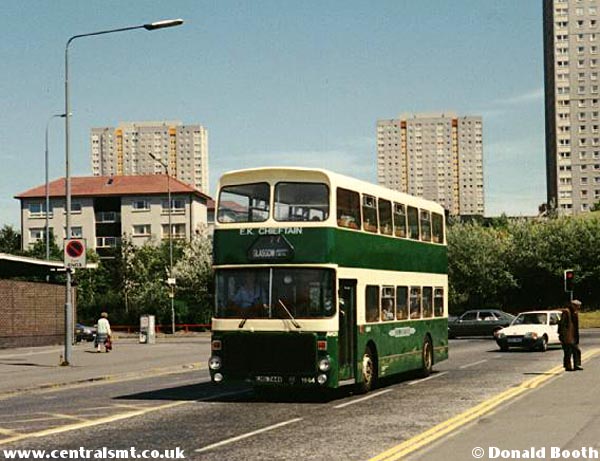The Central Story
1985 - 1989 : Re-organisation and The End
 On 17 June 1985, the Scottish Bus Group was re-organised. Eleven operating companies took the place of the previous seven and the structure was brought more into line with the regional structure for local government applying in Scotland at the time. The new companies were Kelvin Scottish, Clydeside Scottish, Strathtay Scottish and Lowland Scottish, the strangely-named Borders company breaking away from the Eastern Scottish empire.
On 17 June 1985, the Scottish Bus Group was re-organised. Eleven operating companies took the place of the previous seven and the structure was brought more into line with the regional structure for local government applying in Scotland at the time. The new companies were Kelvin Scottish, Clydeside Scottish, Strathtay Scottish and Lowland Scottish, the strangely-named Borders company breaking away from the Eastern Scottish empire.
Central SMT Co. Ltd. was re-named Central Scottish Omnibuses Ltd., in line with other companies in the group. The new company lost the Dunbartonshire services and Old Kilpatrick Depot of Central SMT to the new Kelvin company, but gained Monklands operations and Airdrie's Clarkston Depot from Eastern Scottish. Central wasted little time in re-organising the Monklands operations by integrating them more closely into the core Lanarkshire network, to the undoubted benefit of the travelling public in that area.
A major challenge looming large for the new company was the impending implementation of the Government's deregulation plans in October 1986. Clydeside Scottish and Kelvin Scottish were formed with this specifically in mind and, living up to expectations, both those operators produced an aggressive response. Services were extensively re-cast and an assault was mounted on Glasgow featuring the use of crew-operated AEC Routemasters acquired from London Buses Ltd. In the event - and presumably by all-round agreement - most of the major deregulation networks in the Glasgow area were implemented early, at the end of August 1986. This included substantial extension of Strathclyde Buses services into many parts of Lanarkshire.
Central's response to deregulation was far more low-key. The main features were Glasgow city services 28 (Summerston - Toryglen) and 29 (Anderston X - Castlemilk), minibus services M1 (Rutherglen - Castlemilk) and M2 (Rutherglen - Toryglen), and a peak-hour network of motorway express journeys between Glasgow and Lanarkshire. Although limited in scale and therefore, one would have thought, relatively easy to resource, many aspects of Central's deregulation network were not well executed. High-floor, manual gearbox Leopards frequently ran empty on what should have been the high-profile, cross-city 28 - not helped by blank destination screens! All three Scottish Bus Group subsidiaries in the Glasgow area were to find that the Glasgow public, although fond of complaining about their incumbent operator, would in the event stay fiercely (or perhaps apathetically?) loyal to what many still perceived to be The Corporation.
The next major challenge would be the Government's privatisation agenda. Many people have perfectly valid, politically inspired views on this subject. My own feeling is that, on balance, it was potentially a positive opportunity, ruined by the ill-conceived manner of its execution. The Scottish Bus Group could have been given a British Airways-style privatisation : keeping the organisation together, retaining its wealth of experience and other positive aspects developed over many years, but building on these assets by injecting new capital and fresh ideas, hopefully ensuring a smooth transition to a successful future. But the reality was very different in two key respects.
In the first place, the sell-off (even the terminology had gone down-market!) took place in the aftermath of deregulation, with the group still reeling from its effects. Even worse, the approach taken was to break up the group into its constituent parts and sell these individually. Quite apart from the effect on the group companies themselves, this approach also denied the general public the opportunity to get involved as shareholders. (Anyone who doubts whether the public would have been interested should remember the demand for Stagecoach shares when that company decided to float on the Stock Exchange.) Whatever the agenda was with privatisation of the Scottish Bus Group (and the National Bus Company south of the border), it certainly wasn't about the advance of popular capitalism.
But Central was never to make its return to the private sector. In the run-up to privatisation, it was decided that some of the SBG companies could not be sold in their current form. In particular, the Government made it known that Clydeside would be re-integrated into Western Scottish, while Central would be merged with Kelvin Scottish. News of the planned merger was deeply unpopular with staff at Central, where new flexible rostering agreements, already fully implemented at Kelvin, had not yet been put in place. A disastrous course of events ensued in early 1989, with the company's network paralysed for weeks on end by strike action. In the deregulated environment, of course, other companies simply moved in and cleaned up while Central's life-blood leaked away.
 The dispute was finally resolved in the late Spring of 1989. In a desperate attempt to win back disaffected passengers, Central (already re-named Kelvin Central in preparation for the merger) boldly re-invented itself by creating new local identities. East Kilbride operations became EK Chieftain, both the name and the green-based colour scheme recalling the fleet of Laurie, Hamilton. Airdrie-based services became Monklands Bus, in a dark blue and grey livery inspired by the famous independent Baxter's of Airdrie, whose own identity had been kept alive for many years by Eastern Scottish. Core Lanarkshire services were marketed as Lanarkshire Bus, a more vibrant red and cream scheme superseding the traditional Central colours.
The dispute was finally resolved in the late Spring of 1989. In a desperate attempt to win back disaffected passengers, Central (already re-named Kelvin Central in preparation for the merger) boldly re-invented itself by creating new local identities. East Kilbride operations became EK Chieftain, both the name and the green-based colour scheme recalling the fleet of Laurie, Hamilton. Airdrie-based services became Monklands Bus, in a dark blue and grey livery inspired by the famous independent Baxter's of Airdrie, whose own identity had been kept alive for many years by Eastern Scottish. Core Lanarkshire services were marketed as Lanarkshire Bus, a more vibrant red and cream scheme superseding the traditional Central colours.
But this final, brief burst of innovation and colour could not prevent fate from taking its course. The direct successor of Central SMT, carrying with it the heritage of its illustrious forerunner, passed out of free-standing existence on 17 July 1989 on full enactment of the planned merger with Kelvin Scottish.
And so it really had come to this. Central - the Lanarkshire goldmine and financial powerhouse of the Scottish Bus Group - had finally and quietly bowed out as a separate force in the Scottish transport scene, battered, crippled and broken by internally- and externally-inflicted wounds. Things would never be the same again.
.jpg)